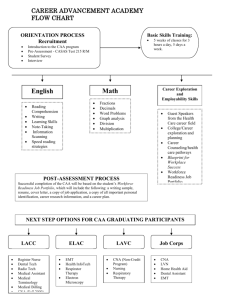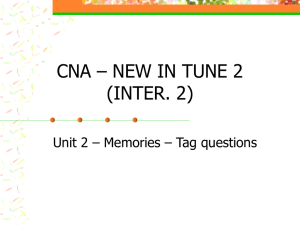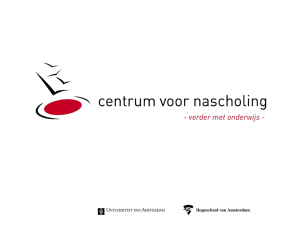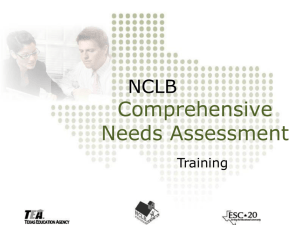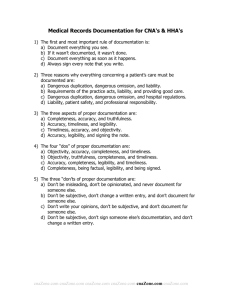Aligning of improvement processes and district/campus practices
advertisement
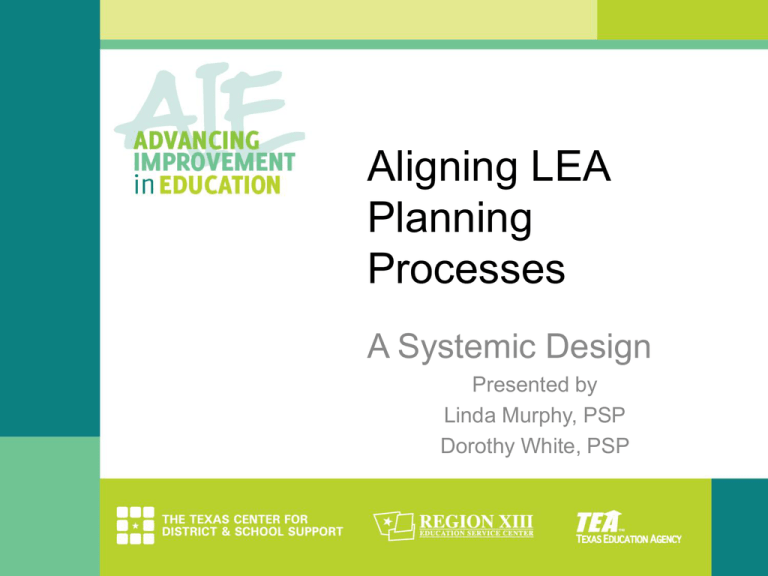
Aligning LEA Planning Processes A Systemic Design Presented by Linda Murphy, PSP Dorothy White, PSP The Big Picture Aligning of improvement processes and district/campus practices Goals by Stephen Covey Goals • Develop foundational understanding of research based systems and needs assessment processes • Incorporate a variety of data sources in the needs assessment processes • Generate new ideas with colleagues to create local systems of improvement planning in compliance with state and federal guidance • Student Level Review (SLR) • TEA Accountability Workbook: Data Analysis • Approved Data Disaggregation Tool • ESC Led Data Analysis • LEA tool • PSP Progress Report • Site Visit Reports • Quarterly Implementation Report (QIR) • Student Level Review (SLR) • Targeted Student Analysis (TSA) • TEA Accountability Workbook: Needs Assessment • Region 20 CNA Tool • ESC Led Needs Assessment • Snapshot • LEA tool • CPE Data Analysis Needs Assessment Implement and Monitor Plan • TEA Accountability Workbook: Improvement Plan • 90 Day Strategy/ Plans • LEA CIP/DIP Tool Working Systemically • SEDL Developed and tested a systemic model designed to improve student achievement in low-performing districts and schools • Collaborated with the Charles A. Dana Center in Austin – 49 schools in 23 districts – Arkansas, Louisiana, New Mexico, Oklahoma, and Texas – Rural, suburban, and urban settings Options…. Fix the parts Transfer innovations Fix the people Improve teacher/administrator knowledge and skills Fix the school Apply organizational development approaches to schools only Fix the system An approach informed by research… What Working Systemically IS NOT Empowered Individuals/Schools No Systemic Approach Working Systemically in Action, SEDL, 2008 9 What Working Systemically IS NOT District’s Purpose Clear District Schools Schools’ Purpose Clear Still No Systemic Approach Working Systemically in Action, SEDL, 2008 10 What Working Systemically IS Classrooms Schools Increased Student Achievement District District’s Purpose Clear/Schools’ Purpose Clear Common Focus on Student Achievement Each Mutually Supportive Working Systemically in Action, SEDL, 2008 11 Bernhardt, Using Data to Improve Student Learning in School Districts, 2006 Data Analysis- Demographics Data Analysis- Perceptions Data Analysis- School Processes Data Analysis-Student Learning Bernhardt, Using Data to Improve Student Learning in School Districts, 2006 Bernhardt, Using Data to Improve Student Learning in School Districts, 2006 Goals by Stephen Covey CNA Link: http://portal.esc20.net/portal/page/portal/NCLB/CNA.htm CNA Spreadsheet 8 CNA Focus Areas Data analysis should not be just about gathering data. It is very easy to get “analysis paralysis” by spending too much time pulling data together and not spending time using the data. -Victoria Bernhardt •Demographics •Student Achievement •School Culture and Climate •Staff Quality, Recruitment and Retention •Curriculum, Instruction, and Assessment •Family and Community Involvement •School Organization •Technology Staff Quality, Recruitment and Retention An empowered organization is one in which individuals have the knowledge, skill, desire, and opportunity to pursue success in way that leads to collective and organizational success Stephen Covey •Staff Quality, Recruitment and Retention refers to the school organization’s level of high-quality, highly-effective staff, in highpoverty schools. This area is also focused on assessing the effect of recruitment and retention strategies on staffing patterns. CNA REFLECTIVE QUESTIONS Reflective Question Activity • Work in pairs or triads • Respond to reflective Questions from CNA tool. • Be prepared to share Creating a School Profile There are three kinds of curricula ;they must be considered together and improved together: written curriculum, taught curriculum, and tested curriculum. – Fenwick English •Decide what you want to measure and report. •Determine who will be responsible for organizing, developing and updating the profile. •Develop a management system for collecting and organizing the data in the profile. •Be selective about the type and amount of data to collect. •Take a baseline assessment of the data available in each area of focus. •Determine any additional information that is needed and the procedures for collecting it. •Write a narrative to support the story the data presents; use varied formats for illustrating the narrative with charts, graphs, tables. Process Create the kind of climate in your organization where personal growth is expected, recognized and rewarded. -Author Unknown Step 1 – Review the purpose and outcomes for conducting the CNA Step 2 – Establish committees for each area of the CNA Step 3 – Determine which types of data will be collected and analyzed by the committee to develop the school profile Step 4 – Determine areas of priority and summarize needs Step 5 – Connect the CNA to the district/campus improvement plan development and review process How can your LEA/Campus incorporate alternative planning procedures in order to implement a research based aligned process that is in compliance with state and federal guidelines and with a direct connection to improvement initiatives? Resources TEA • • Guidance for the Texas Accountability Intervention System http://www.tea.state.tx.us/index2.a spx?id=2147495563&menu_id=21 47483703&menu_id2=214748371 6 (HINT: TEA Accountability Monitoring web page) ESC 20 CNA tool http://portal.esc20.net/portal/page/ portal/NCLB/CNA.htm References • • Cowan, D., Joyner, S., & Beckwith, S. (2008). Working Systemically in action: A guide for facilitators. Austin, TX: SEDL. Bernhardt, Victoria L. (2006). Using data to improve student learning in school districts. Larchmont, NY: Eye On Education. Contact Information Dorothy White dwhite.ss4u@gmail.com 281.748.6442 Linda Murphy lmmurphy@hughes.net 936.635.6911

